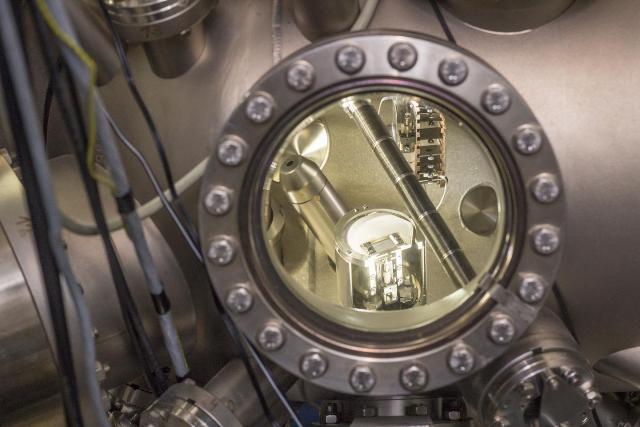 This image shows an iron oxide sample in the vacuum chamber. Credit: TU Wien
This image shows an iron oxide sample in the vacuum chamber. Credit: TU Wien
Researchers at the Vienna University of Technology have revealed that the missing iron atoms in Magnetite’s (Fe3O4) sub-surface layer, govern its properties. "It turns out that the surface of Fe3O4 is not Fe3O4 at all, but rather Fe11O16," says Professor Ulrike Diebold, head of the metal-oxide-research group at TU Wien (Vienna).
Magnetite is a complicated type of rust that is composed of a regular lattice of iron and oxygen atoms. It is an important catalyst that is used in medical and electronics applications.
The study shows that the missing iron atoms in the magnetite’s sub-surface layer make the material an extremely efficient catalyst for chemical reactions. The assumption about the magnetite surface's atomic structure was well-established, however had been wrong the entire time.
When single atoms of materials such as palladium or gold are placed on a magnetite surface, they do not ball up or form a nanoparticle, but they remain in their place. This is considered to be the most unexpected property of the surface. This unique effect provides the very efficient catalytic property.
However, until now nobody has been able to figure out the reason for magnetite's behavior.
"Also, Fe3O4-based electronics never function quite as well as they should", says Gareth Parkinson (TU Wien), "because materials interact with their environment through the surface, it's really important to understand the structure of the surface and why it forms."
Usually, the oxygen vacancies in the uppermost layers influence the properties of the metal oxides. Here, a few oxygen atoms may be missing and this in turn influences the material’s electronic properties. "Everyone in our community thinks about missing oxygen atoms. That is why it took us quite a while to figure out that it is in fact missing iron atoms that do the trick", says Gareth Parkinson.
Iron oxides are considered to be a defined oxygen structure with a few metal atoms, but not a metal atom fixed structure having built-in oxygen atoms. Below the outermost atomic layer, a few iron atoms are missing in the rearranged crystal structure.
Other metal atoms, such as of gold or palladium, can attach at these iron-vacancy-sites, easily, and as these sites are regularly spaced and a well-defined distance always exists between them, these metal atoms are prevented from forming clusters.
Since this new proposal about magnetite’s crystal structure was a daring suggestion, the researchers performed quantum simulation on large supercomputers to prove the physical reasonability of the proposed structure. TU Wien scientists then collaborated with researchers from the University of Erlangen-Nuremberg to conduct electron diffraction measurements.
"By scattering slow electrons at surfaces, one can measure how well the actual crystal structure of the material agrees with a theoretical model", says Ulrike Diebold.
R-values quantified this statement. "For very well-known structures, one may achieve an R-value of 0.1 or 0.15. For magnetite, nobody had ever managed to get anything better than 0.3, and people said it just could not be done." However, the new magnetite structure with missing iron atoms yielded an R-value of 0.125 which matched the experimental data.
Metal oxides are important from the technological point of view. However, they are very difficult to describe. "Our results show that there is no need to despair. Metal oxides can be modelled quite accurately after all, but maybe not in the way one might expect at first glance", says Gareth Parkinson.
The researchers hope that the present study’s findings could also be valid for oxides of other materials such as nickel, manganese and cobalt. This re-thinking of metal oxide crystal structures could advance research in iron-oxides in different areas. Furthermore, this could help develop applications in electronics, medicine and chemical catalysis.
The "Solids4fun" doctoral college has been set up by TU Wien to advance collaborations between surface science and materials, and the present project builds bridges between chemistry and physics.
This study has been published in the journal, Science.